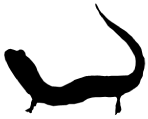Salamanders and newts are nocturnal and secretive animals with long
slender bodies, long tails and in most cases, two pairs of legs. Their life cycles can be totally aquatic, totally terrestrial, and in
between--spending time both on land and in water.  Their skin is actually a respiratory surface, allowing
oxygen to enter the body. The
outer layer of skin is frequently shed and usually eaten. Salamanders and newts eat
a varied diet including small invertebrates, insects, slugs, snails, and
worms. They in turn provide food and are eaten by shrews, birds, snakes,
other salamanders, beetles, centipedes, and spiders.
Their skin is actually a respiratory surface, allowing
oxygen to enter the body. The
outer layer of skin is frequently shed and usually eaten. Salamanders and newts eat
a varied diet including small invertebrates, insects, slugs, snails, and
worms. They in turn provide food and are eaten by shrews, birds, snakes,
other salamanders, beetles, centipedes, and spiders.
Biologists studying newts and salamanders have found that many of these
animals have remarkable orientation and homing abilities. These animals can
disperse from their birth places to several kilometers away or more. Other
studies demonstrated that individual animals were able to find their way
back to the exact stretch of stream where they were caught. Vision and smell
seem to be important to navigation but even blind individuals find their
way. Biologists think that the pineal body in the brain is sensitive to light
and aids these animals in navigating by cuing them in to the sun’s position
in the sky even on cloudy days. Other studies have shown that cave
salamanders and red-spotted newts can detect the earth’s magnetic field and
will use it as a navigation cue.